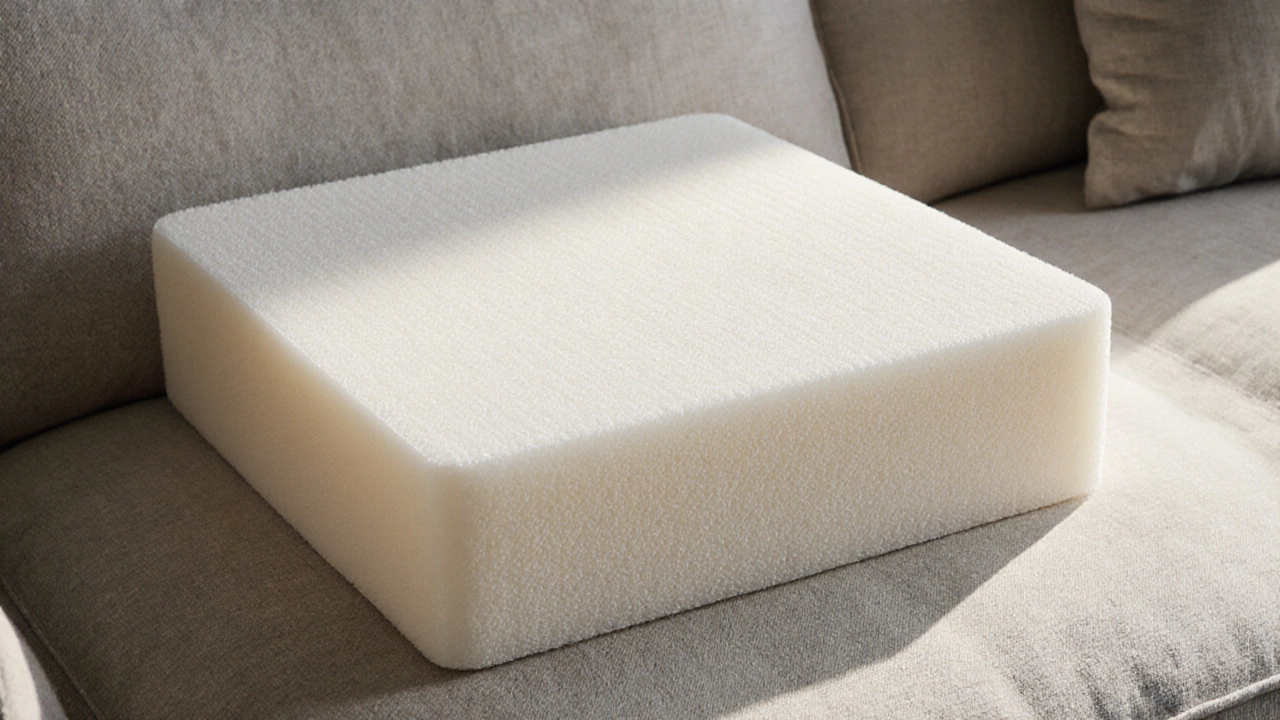What Are the Longest Lasting Couch Cushions? Top Materials and Brands That Don’t Flatten
 Nov, 16 2025
Nov, 16 2025
Cushion Density Calculator
Find Your Perfect Cushion Density
Select your usage patterns to determine the recommended foam density for durable, long-lasting cushions.
Recommended Foam Density
Most people don’t think about their couch cushions until they sink like sandbags after just a year or two. You sit down, and instead of that firm, supportive feel you loved when you bought it, your butt hits the frame. That’s not just uncomfortable-it’s expensive. Replacing a whole sofa? That’s a few thousand dollars. Replacing just the cushions? A fraction of that, if you know what to look for.
Why Some Cushions Last and Others Don’t
The secret isn’t brand name or price tag. It’s what’s inside. Most couch cushions use one of three core materials: polyurethane foam, down/feather blends, or a mix of both. Each behaves differently over time.
Low-density foam-often found in budget sofas-breaks down fast. It starts out soft, but after six months of regular use, it loses its spring and turns into a flat, lumpy mess. You’ve probably sat on one. You know the feeling.
High-density foam, on the other hand, holds up. Look for foam with a density of 2.5 pounds per cubic foot or higher. That’s the sweet spot. It’s firm enough to support your weight without crushing, and it retains its shape for 8-12 years if you flip and rotate the cushions every few months. Brands like IKEA’s ÅKERÖ and Pottery Barn’s Classic Cushion use this density in their premium lines.
Down and feather blends feel luxurious, but they’re not built for daily use. Pure down compresses quickly. A down blend-say, 50% down, 50% feather-lasts longer because the feathers add structure. But even then, they’ll need fluffing every day and replacement every 3-5 years if you use the sofa daily. They’re great for occasional lounging, not for families with kids or pets.
The Best Materials for Longevity
If you want cushions that last a decade or more, stick to these three options:
- High-density foam (2.5+ lb/ft³): The gold standard for durability. Resists compression, doesn’t sag, and holds its shape. Often wrapped in a thin layer of polyester fiber to soften the feel without sacrificing support.
- Memory foam core with high-density foam base: Memory foam conforms to your body, but alone, it’s too soft for long-term use. Layer it over a firm foam base, and you get comfort without collapse. Brands like Tempur-Pedic and Sleep Number use this in their sofa cushions.
- Down blend with a foam core: This hybrid gives you the plush feel of down without the rapid flattening. The foam core keeps structure, while the down adds softness. Look for cushions labeled “down-wrapped foam.”
Avoid anything labeled “polyester fiberfill” alone. That’s the cheap stuffing used in throw pillows. It’s fine for decoration, but it turns to dust under regular weight.
What to Look for When Buying Replacement Cushions
You don’t need to buy a whole new sofa. Replacing cushions is cheaper, faster, and often better than trying to fix old ones.
Here’s what to check before you buy:
- Measure precisely. Take the length, width, and depth of your current cushion. Don’t guess. Even a half-inch difference can make the cover look crooked or the cushion feel too tight.
- Check the zipper. Good cushions have a hidden zipper that lets you remove the cover for cleaning. If the cover is sewn shut, you’re stuck with whatever’s inside.
- Ask for density specs. Don’t settle for “premium foam.” Ask: “What’s the density in lb/ft³?” If they can’t tell you, walk away.
- Look for removable, washable covers. Even the best foam gets dirty. A removable cover made of performance fabric like Crypton or Sunbrella will last longer and stay cleaner.
- Test the firmness. Sit on the cushion if you can. It should feel supportive, not like you’re sinking into a hammock. If it gives too much, it’ll flatten fast.

Top Brands That Make Cushions That Last
Not all brands are created equal. Here are the ones that consistently deliver durability, based on consumer reports, warranty lengths, and real-world reviews:
| Brand | Core Material | Density | Warranty | Best For |
|---|---|---|---|---|
| Pottery Barn | High-density foam with fiber wrap | 2.8 lb/ft³ | 1 year (cover), 5 years (foam) | Classic style, medium firmness |
| West Elm | High-density foam + down blend | 2.6 lb/ft³ | 1 year (cover), 5 years (foam) | Modern design, plush feel |
| IKEA (ÅKERÖ) | High-density foam | 2.5 lb/ft³ | 10 years (foam) | Value, durability, easy replacement |
| Crate & Barrel | Memory foam core + high-density base | 3.0 lb/ft³ | 1 year (cover), 10 years (foam) | Heavy use, people with back pain |
| Lutron | High-density foam with quilted cover | 3.2 lb/ft³ | 15 years (foam) | Extreme durability, commercial use |
Lutron might sound unfamiliar, but they supply cushions to hotels and high-end offices. Their 15-year foam warranty isn’t marketing-it’s real. If you want cushions that outlive your kids’ college years, this is the brand.
How to Extend the Life of Your Cushions
Even the best cushions wear out faster if you ignore basic care.
- Flip and rotate weekly. If you sit in the same spot every day, the foam compresses unevenly. Flip front-to-back and rotate left-to-right. It takes 30 seconds and doubles the lifespan.
- Use a slipcover. A washable slipcover protects against spills, pet hair, and UV fading. Sunlight breaks down fabric and foam over time.
- Keep pets off the cushions. Cat claws and dog nails shred fabric and dig into foam. If you can’t keep them off, get cushions with a tightly woven, high-thread-count cover.
- Avoid direct sunlight. UV rays make foam brittle. If your sofa sits near a window, close the blinds during peak sun hours.
- Don’t jump on it. That’s not fun-it’s destructive. Every impact fractures the foam structure. You won’t see it right away, but after a year, the damage shows.
When to Replace vs. Repair
Not every saggy cushion needs replacing. Sometimes, a simple fix works:
- If the cover is torn but the foam is still firm, replace just the cover. You can buy custom covers online for under $50.
- If the foam is flat but still intact, try adding a foam insert. Cut a 1-inch layer of high-density foam to fit inside the cushion. It’s cheap, easy, and gives you a year or two more.
- If the cushion is lumpy, uneven, or smells musty, it’s time to replace. Foam that’s broken down can’t be revived.
Don’t waste money on “cushion fluffers” or sprays. They don’t restore foam. They just make it smell nice while it keeps sinking.
What Happens When Cushions Die
Most people don’t realize how much waste couch cushions create. Foam doesn’t biodegrade. Down and feathers end up in landfills. Some cities offer textile recycling, but it’s rare.
If you’re replacing cushions, consider donating your old ones to a furniture bank or animal shelter. Many shelters use old cushions for pet beds. Or, if the foam is still in decent shape, cut it into smaller pieces and use it as packing material or DIY pet beds.
Buying durable cushions isn’t just about comfort. It’s about reducing waste, saving money, and not having to redo your living room every few years.
What’s the most durable material for couch cushions?
High-density foam with a density of 2.5 pounds per cubic foot or higher is the most durable. It holds its shape for 8-12 years with regular use. Down blends are soft but compress faster. Memory foam alone sags; it needs to be layered over firm foam to last.
Can I replace just the cushions on my sofa?
Yes, and it’s often smarter than buying a whole new sofa. Most sofas have removable cushions with zippers. Measure your old ones, find replacements with matching density and size, and swap them out. It costs 20-30% of a new sofa and takes less than an hour.
How often should I flip my couch cushions?
Flip and rotate them every week if you use the sofa daily. Even if you only sit in one spot, the foam compresses unevenly. Regular rotation spreads the wear and can extend the life of your cushions by 50% or more.
Are down cushions worth it for daily use?
Only if you use the sofa lightly. Pure down flattens in months. A down blend (50/50) lasts longer and feels plush, but it still needs daily fluffing. For families, pets, or daily use, foam cores are more practical and longer-lasting.
What’s the best way to clean couch cushion covers?
Check the care label. Most high-quality covers are removable and machine-washable. Use cold water and mild detergent. Avoid bleach and high heat-both damage the fabric and the foam inside. Air dry completely before putting them back on.
Do memory foam cushions sag over time?
Yes, if they’re used alone. Memory foam is soft and slow to rebound. But when it’s layered over a firm high-density foam base, it lasts. Look for cushions labeled “memory foam core with support base.” That combo gives you comfort without the collapse.
Are there any eco-friendly cushion options?
Yes. Some brands use plant-based foams made from soy or castor oil instead of petroleum. These are less toxic and have a lower carbon footprint. Look for certifications like CertiPUR-US or OEKO-TEX. They’re not perfect, but they’re better than standard foam.
Your couch is one of the most used pieces of furniture in your home. It deserves better than cheap stuffing that turns to mush. Choose durable materials, care for them, and you won’t just save money-you’ll sit better, longer, and with less guilt about waste.